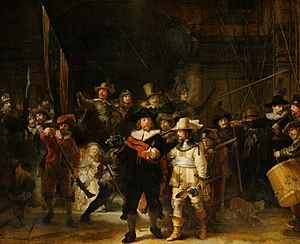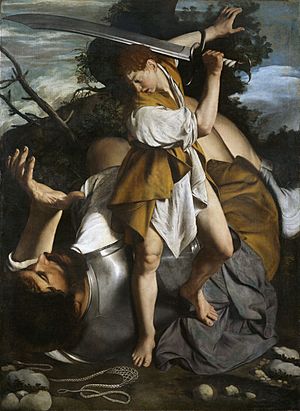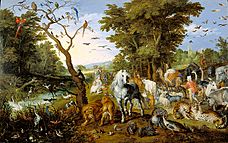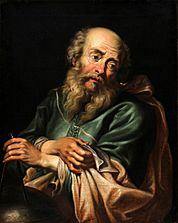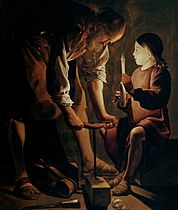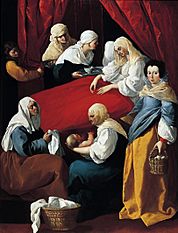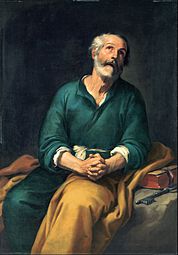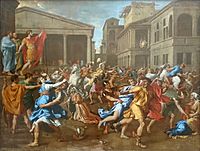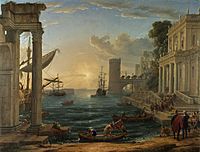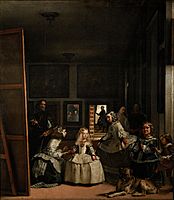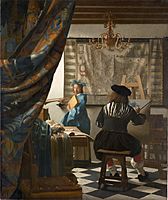Baroque painting facts for kids
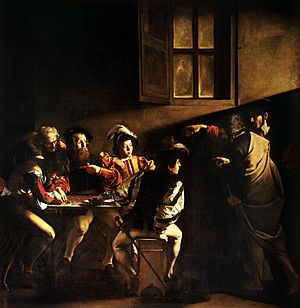
Baroque painting is a style of art that was popular from about 1600 to the early 1700s. It was part of a bigger cultural movement called the Baroque period. This art style is known for being very dramatic and emotional. It often used rich, deep colors and strong contrasts between light and dark.
Baroque art was popular in many places, including countries ruled by powerful kings (like in absolutist states) and those involved in the Counter Reformation (a time when the Catholic Church made changes). But it was also loved in Protestant countries, showing how widely it spread across Europe.
Unlike Renaissance art, which often showed the quiet moment before something happened, Baroque artists chose the most exciting part. They showed the exact moment the action was taking place. For example, Michelangelo's statue of David looks calm before his fight. But Bernini's Baroque statue of David is caught right in the middle of throwing the stone at Goliath. Baroque art wanted to make people feel strong emotions and passion, not just calm thoughts.
Some of the most famous Baroque painters include Velázquez, Caravaggio, Rembrandt, Rubens, Poussin, and Vermeer. Caravaggio was known for painting people very realistically, often with bright spotlights against dark backgrounds. This style, called chiaroscuro, made his paintings very dramatic. You can also see this strong light and shadow in works by Rembrandt and La Tour.
The Flemish painter Anthony van Dyck created elegant and powerful portraits that became very popular, especially in England. In the 1600s, Holland became very wealthy, which led to many artists creating different types of paintings. These included scenes of everyday life, landscapes, still lifes (paintings of objects), and portraits. Dutch artists were very skilled and created new kinds of art that influenced painting for a long time.
Contents
What is Baroque Painting?
The Roman Catholic Church had a big meeting called the Council of Trent (1545–1563). During this meeting, they talked about how art should be used in churches. They decided that paintings and sculptures should show their subjects clearly and powerfully. They wanted art to inspire faith and be easy for everyone to understand.
This idea helped inspire artists like Caravaggio and the Carracci brothers in Rome around 1600. They created art that was more direct and emotional. Even though religious art and portraits were still very important, other types of paintings became popular too. These included landscapes, still lifes, and scenes from daily life. These types of art were especially common in Protestant countries.
Where Did the Name "Baroque" Come From?
The word "Baroque" was first used to describe something that was too fancy or overdone. Some people think it came from a word that meant a complicated way of thinking.
At first, people used "Baroque" to criticize the art style, saying it had too many details and was too loud compared to the simpler art of the Renaissance. But later, an art historian named Heinrich Wölfflin helped people see Baroque art differently. He described it as art that showed a lot of "movement" and was very different from Renaissance art. Thanks to his work, "Baroque" became a respected term in art history.
Different Styles of Baroque Art
Baroque art looked a bit different depending on the country.
In countries like Italy and Spain, and later in Germany, artists often used the full, dramatic Baroque style. This meant lots of emotion, grand scenes, and strong contrasts.
However, in 17th-century Holland, a different style developed. This was called Dutch Golden Age painting. Dutch artists painted very few religious scenes. Instead, they focused on everyday life, landscapes, and still lifes. While artists like Rembrandt clearly used Baroque ideas, the term is less often used for painters like Vermeer. Dutch art often felt less grand and more realistic than other Baroque art.
In France, Baroque painting had a more elegant and graceful feel. It was often more classical, meaning it followed rules of balance and order. Two important French artists, Nicolas Poussin and Claude Lorrain, lived in Rome. Their paintings, often smaller easel paintings, were loved by both Italian and French art lovers.
Famous Baroque Painters
Here are some well-known Baroque painters from different countries:
British Painters
- William Dobson (1611–1646)
- George Jamesone (1587–1644)
- Godfrey Kneller (1646–1723)
- Peter Lely (1618–1680)
- Daniël Mijtens (1590–1648)
- John Michael Wright (1617–1694)
Dutch Painters
- Rembrandt (1606–1669)
- Hendrick Avercamp (1585–1634)
- Gerard ter Borch (1617–1681)
- Adriaen Brouwer (1605–1638)
- Hendrick ter Brugghen (1588-1629)
- Aelbert Cuyp (1620–1691)
- Gerrit Dou (1613–1675)
- Jan van Goyen (1596–1656)
- Frans Hals (1580–1666)
- Meindert Hobbema (1638–1709)
- Gerard van Honthorst (1592–1656)
- Pieter de Hooch (1629–1684)
- Willem Kalf (1619–1693)
- Pieter van Laer (1599–1642)
- Judith Leyster (1609–1660)
- Gabriël Metsu (1629–1667)
- Adriaen van Ostade (1610–1685)
- Jacob van Ruisdael (1628–1682)
- Salomon van Ruysdael (1602–1670)
- Pieter Jansz. Saenredam (1597–1665)
- Johannes Vermeer (1632–1675)
- Jan Steen (1626–1679)
Czech (Bohemian) Painters
- Václav Hollar (1607–1677)
- Karel Škréta (1610–1674)
- Petr Brandl (1668–1735)
- Václav Vavřinec Reiner (1686–1743)
Flemish Painters
- Peter Paul Rubens (1577–1640)
- Anthony van Dyck (1599–1641)
- Jacob Jordaens (1593–1678)
- Jan Brueghel the Elder (1568–1625)
- Frans Francken the Younger (1581–1642)
- Clara Peeters (1594–1657)
- Gerard Seghers (1591–1651)
- Frans Snyders (1579–1657)
- David Teniers the Younger (1610–1691)
- Adriaen van Utrecht (1599–1652)
- Cornelis de Vos (1584–1651)
French Painters
- Valentin de Boulogne (1591–1632)
- Philippe de Champaigne (1602–1674)
- Laurent de La Hyre (1606–1656)
- Georges de La Tour (1593–1652)
- Charles Le Brun (1619–1690)
- Le Nain brothers :
- Antoine Le Nain (c. 1599–1648)
- Louis Le Nain (c. 1593–1648)
- Mathieu Le Nain (1607–1677)
- Eustache Le Sueur (1617–1655)
- Claude Lorrain (1600–1682)
- Pierre Mignard (1612–1695)
- Hyacinthe Rigaud (1659–1743)
- Nicolas Poussin (1594–1665)
- Simon Vouet (1590–1649)
German Painters
- Cosmas Damian Asam (1686–1739)
- Adam Elsheimer (1578–1610)
- Johann Liss (1590–1627)
- Sebastian Stoskopff (1597–1657)
Hungarian Painters
- Ádám Mányoki (1673–1757)
Italian Painters
- Federico Barocci (1535–1612)
- Jacopo Chimenti (1554–1640)
- Giovanni Battista Paggi (1554–1627)
- Antonio Tempesta (1555–1630)
- Bartolomeo Cesi (1556–1629)
- Alessandro Maganza (1556–1640)
- Bernardo Castello (1557–1629)
- Lodovico Cigoli (1559–1613)
- Enea Talpino (1559–1626)
- Bartolommeo Carducci (1560–1610)
- Caravaggio (1571–1610)
- Guercino (1591–1666)
- Annibale Carracci (1560–1609)
- Guido Reni (1575–1642)
- Giuseppe Passeri (1654-1714)
- Orazio Gentileschi (1563–1639)
- Artemisia Gentileschi (1592– c. 1656)
- Domenichino (1581–1641)
- Agostino Carracci (1557–1602)
- Ludovico Carracci (1555–1619)
- Bernardo Strozzi (1581-1644)
- Pietro da Cortona (1596–1669)
- Giovanna Garzoni (1600-1670)
- Virginia Vezzi (1601-1638)
- Gregorio Preti (1603–1672)
- Francesco Cozza (1605–1682)
- Mattia Preti (1613–1699)
- Salvator Rosa (1615–1673)
- Luca Giordano (1634-1705)
- Elisabetta Sirani (1638-1665)
- Andrea Pozzo (1642–1709)
Polish Painters
- Jan Reisner (1655–1713)
- Jerzy Siemiginowski-Eleuter (1660–1711)
- Szymon Czechowicz (1689–1775)
- Bartlomiej Strobel (1591–1650)
- Krzysztof Boguszewski (1635)
Portuguese Painters
- Josefa de Óbidos (1630–1684)
Spanish Painters
- José Antolínez (1635–1675)
- Alonso Cano (1601–1667)
- Juan Carreño de Miranda (1614–1685)
- Claudio Coello (1642–1693)
- Juan van der Hamen (1596–1631)
- Juan Bautista Maíno (1569–1649)
- Juan Bautista Martínez del Mazo (1612–1667)
- Bartolomé Esteban Murillo (1617–1682)
- Antonio de Pereda (1611–1678)
- Lorenzo Quiros (1717 – 1789)
- Francisco Ribalta (1565–1628)
- José de Ribera, Lo Spagnoletto (1591–1652)
- Juan de Valdés Leal (1622–1690)
- Diego Velázquez (1599–1660)
- Tomás Yepes (1595 or 1600 – 1674)
- Francisco Zurbarán (1598–1664)
Gallery
-
Caravaggio, Bacchus, c. 1595.
-
Frans Hals Gypsy Girl, 1628–30.
-
Nicolas Poussin, The ... the Sabine Women, 1637–38.
-
Salvator Rosa, Philosophy, Of Silence and Speech, Silence is better, 1640.
-
Diego Velázquez, Las Meninas, 1656–57.
-
Rembrandt van Rijn, The Syndics of the Clothmaker's Guild, 1662.
-
Jan Vermeer, The Allegory of Painting or The Art of Painting, 1666–67.
See Also
 In Spanish: Pintura del Barroco para niños
In Spanish: Pintura del Barroco para niños
- Baroque illusionistic painting
- History of painting
- Western painting
- Rococo Painting
Reading
- Mark Getlein, Living With Art, 8th edition.
- Gombrich, E.H., The Story of Art, Phaidon, 1995. ISBN: 0-7148-3355-X
- Michael Kitson, 1966. The Age of Baroque
- Heinrich Wölfflin, 1964. Renaissance and Baroque (originally published in German, 1888) ISBN: 0-8014-9046-4


